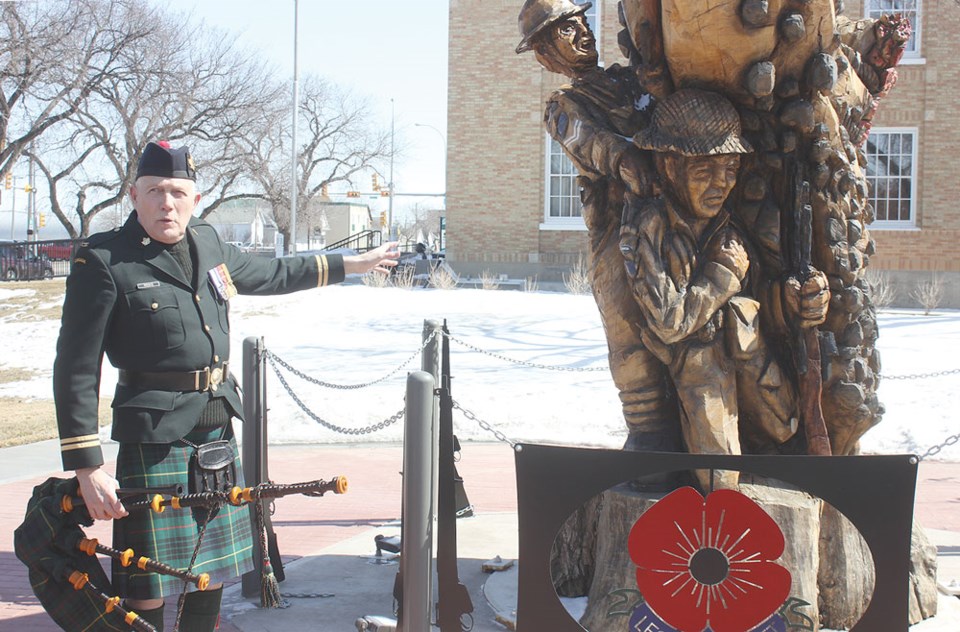Those who attended the cenotaph service in honour of the 101st anniversary of the Battle of Vimy Ridge last Saturday also learned more about the Soldiers’ Tree monument and the local cenotaph itself.
The No. 2901 Estevan Army Cadet Corps and the Royal Canadian Legion’s Estevan branch teamed up to host the activities commemorating the Vimy anniversary last week. Most of the ceremonies were held at the legion, but there was also the cenotaph service, which included the wreath ceremony, and a speech by Capt. Robert Rooks from the army cadets.
Starting with the Soldiers’ Tree, Rooks said the tree brings to mind stories of friends, aunts and uncles, and brothers who served.
He pointed to the image of two soldiers engraved next to an explosion.
“So the soldier that’s most in front has been wounded, and the other soldier is helping him out of a bad situation,” said Rooks. “There are two military principles staring you in the face right off the bat.”
Rooks noted the soldiers have a strong grip on their rifles, since soldiers know they can never let go of their rifle. The other principle is the importance of the buddy system in battle.
“They realize that if they help each other out, some of us will go home,” said Rooks.
Both soldiers have South Saskatchewan Regiment shoulder flashes, since this was the regiment formed in southeast Saskatchewan. Up above them is a replica of the queen’s colour of the regiment.
“The colour is the most precious object of a regiment, and soldiers will defend it to their life,” Rooks said.
Soldiers don’t go into battle by themselves, he said. It’s a group effort with the army, navy and air force.
At the top of the monument stand a pilot and a spitfire, and a sergeant resting on his arms in honour of the soldiers who have died in war.
A field grave and some poppies are found on the monument. There is also the image of a female air force sergeant carved into the tree.
“Prior to recent times, females were not allowed in the combat arms, but they are now,” said Rooks. “That picture was taken off a recruiting poster that said ‘We serve so that they can fight.’ So they played an important part in the Canadian military back then, even though they weren’t involved in the actual fighting.”
The monument also has a cap badge for the South Saskatchewan Regiment, and two selections of poetry, including one by Estevan’s Lester Hinzman, whose father was a sergeant in the Regina Rifle Regiment, which landed on the beaches of Normandy on D-Day in 1944.
Two wooden benches are on the site of the monument, with soldiers crafted into the end of each bench. One of the soldiers is from the Princess Patricia’s Canadian Light Infantry, who were the first soldiers to face the enemy in the First World War.
The tree was sculpted by Alberta chainsaw artist Darren Jones out of a cottonwood tree that was more than 100 years old, and it was dedicated in September 2016.
As for the cenotaph, Rooks said most communities across the country have a cenotaph of some kind. The local cenotaph has the names of local veterans who perished during the First World War, the Second World War and the Korean War.
“All across Canada, where there are cenotaphs, these soldiers, sailors and airmen can be found,” said Rooks.
The local cenotaph was constructed between the First World War and the Second World War, Rooks said. It also has the names of locations where local soldiers fought during the First World War, including the Battle of Vimy Ridge.
The Battle of Vimy Ridge occurred from April 9-12, 1917. Canadian soldiers dislodged the Germans from the key strategic point in northeast France. It is widely viewed as a key moment in Canadian history.
Local events to mark the anniversary are held on the Saturday before April 9 every year.



